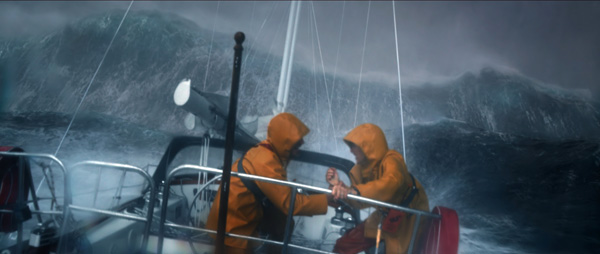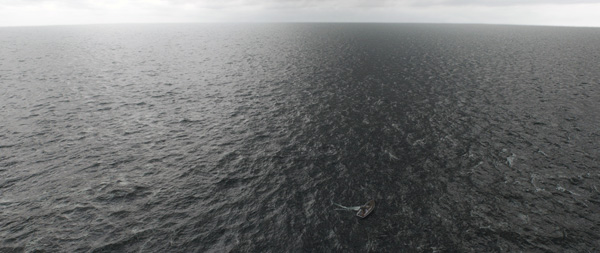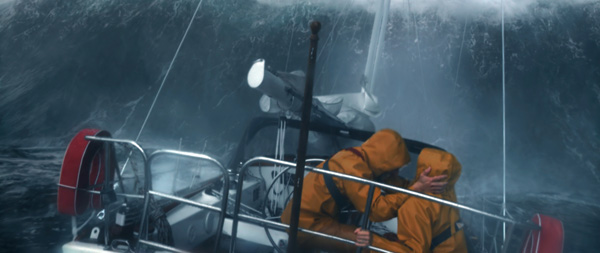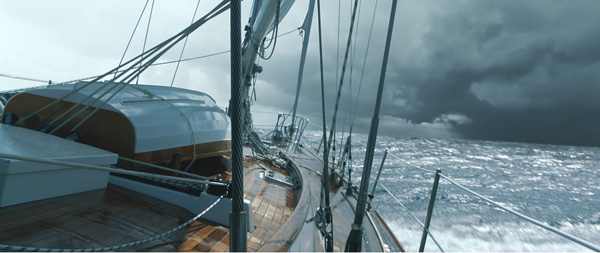To prepare for water simulations for 'Adrift', Milk wrote custom scripts for Houdini and AWS Thinkbox Deadline to simulate locally and render in the cloud using Amazon EC2 instances.
Milk Visual Effects Rides the Waves for 'Adrift' on AWS Cloud

Based on a true story, 'Adrift' follows two sailors as they journey across the ocean, unexpectedly sailing directly into one of the most violent hurricanes in history. Shot on location in Fiji, Milk Visual Effects helped realise critical moments in the story, including a storm sequence in which a 100-foot wave capsizes their 44ft yacht, and a long wide shot establishing the widespread destruction of the storm’s aftermath.
By the end, Milk delivered 170 VFX shots for 'Adrift', 70 of which featured a stormy ocean, in around 10 months with a team that averaged 20 artists at a time. In preparation for the project, Milk optimised its workflow for the heavy FX simulations. Developers built custom scripts for SideFX’s Houdini 3D FX package and AWS Thinkbox Deadline to allow artists to simulate locally and render with Mantra in the cloud using Amazon EC2 Spot instances.

Pipeline Architecture
Their preparation proved worthwhile - during the project’s six-week rendering phase, the studio's team scaled to nearly 10 times its on-premises capacity, averaging 80K computing cores per day and hitting a peak of 132K simultaneous cores in the final stretch.
Milk’s pipeline was architected around Deadline in 2013 with the intention of tapping into cloud resources, and the studio has experimented using cloud-based compute power since 2015. The success Milk has achieved with AWS has helped it continue to grow beyond its start as a very small team, maturing into a very capable mid-sized studio. Having recently celebrated its fifth anniversary, Milk has been recognised for its work across features and television, already earning an Academy, Emmy and three BAFTA Awards, among many other nominations.

With a current artist capacity of 220 between its London headquarters and Cardiff location, Milk’s studios are linked by Deadline, which runs as one resource across both sites, as well as launching the cloud-based render resources as needed. This enables Milk to configure any combination of on-premises and cloud resources as one cohesive farm that can be adjusted for extreme highs and lows in compute demand.
Virtual Workstations
Beyond rendering, Milk sees potential for shifting more work to the cloud in the future. Milk Head of FX and CG Supervisor James Reid said, “We’re interested in exploring the execution of heavy simulations and data creation in the cloud. That way, making sure local machine specs are up to date and how data flows from workstations to the cloud are less of a concern. Virtual workstations could certainly help with some of our pain points and we’re experimenting with where they might fit within our setup.”

The 'Adrift' project revealed some of those pain points. “Water simulation is especially demanding because audiences have an intuitive feeling of what it should look like and it’s highly complex to generate. Simulations A produce a huge amount of data, and so reliable render capacity was a main consideration in developing our workflow for ‘Adrift’,” he said. “Deadline allows us to be productive while processing data and we’re able to execute on a much bigger scale with AWS resources.”
Creatively and technically, the storm sequence proved to be the most complex shot for Milk on 'Adrift'. The sequence reaches a climax with a shot that the team called the ‘pitch pole’ shot. It begins with a wide view of a stormy ocean with the boat careering toward, then riding up a massive wave before transitioning to the interior cabin as the boat capsizes and the camera pulls back into the water.

More than 3,000 frames long, the sequence required Milk artists, led by VFX Supervisor Sara Bennett, to create the wave, which was largely animated by hand for perfect timing and mass, and stitch together plates from four live action cameras and three CG cameras to deliver one continuous shot. “The pitch pole shot ended up requiring 62 TB, a lot of which is FX caching. When we wanted to render, we couldn’t have done it without the AWS cloud,” said Benoit Leveau, Milk Head of Pipeline.
After the Storm
With more than 7,000 frames, the post-storm wide shot was Milk’s longest sequence for the film. James said, “When you submit work to the farm, you want see those frames return quickly, no matter how many there are. Having cloud resources results in more fluid iteration and that leads to better work.”

Benoit said, “We can use AWD to access different resources, such as 96 cores with 256 GB RAM - or even more cores or RAM – for as short or as long as we need without investing in extra equipment. Reliable machines are readily available and the specifications are constantly upgraded, something we wouldn’t be able to do with physical machines.”
“The VFX work we did for ‘Adrift’ is ten times bigger than anything we’ve tackled previously in terms of scope, and it wasn’t the only project we were working on at the time,” said Milk Head of Systems Dave Goodbourn. “Using Deadline with AWS allowed us to be agile and complete all of the workregardless of our size.” https://aws.amazon.com/media/


